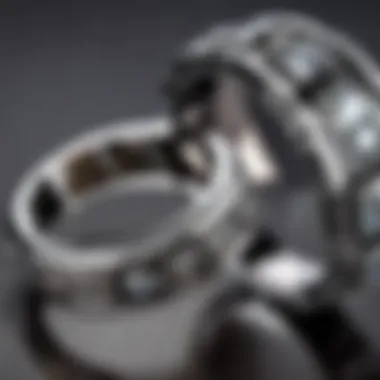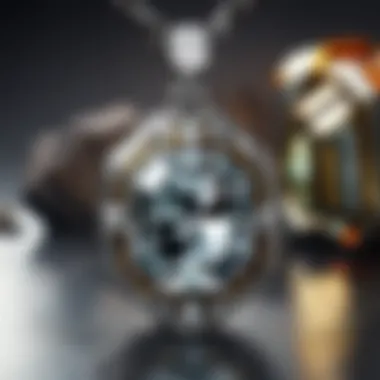Comparing Platinum and Diamond: Distinct Luxuries


Intro
In a world where luxury often speaks through materials, both platinum and diamond have carved a space for themselves that resonates with sophistication and elegance. Understanding the differences between these two can be as intricate as the elements themselves. Not only do they serve as symbols of wealth, but they also embody stories that connect cultures, time periods, and personal sentiments.
Platinum, with its remarkable strength and rarity, is often favored for its durability in jewelry. It is not just a pretty face; its properties render it highly functional. Meanwhile, diamonds, beloved for their captivating sparkle and symbolic representations of eternity, are more than just adornments; they are rooted deep within the historical and cultural narratives of human society.
So, what makes these materials stand out in the vast sea of luxury? This article aims to delve into their properties, uses, and cultural significances, comparing their strengths and weaknesses. Let's embark on this journey to unravel the luxurious duel of platinum and diamond — a nexus of science, history, and modern elegance.
Preamble
In the world of luxury materials, few commodities hold the prestige and allure that platinum and diamond possess. These elements are not just beautiful; they're embedded in human culture, representing wealth, love, and status. As we navigate this article, we will unfold the distinct characteristics of platinum and diamond, examining their historical significance, properties, uses, and influences on contemporary society. Not only will we discuss their physical attributes, but we will also touch on the emotional and cultural connections surrounding these luxurious materials. The reader will leave with a deeper understanding of how these two elements stand in a league of their own.
Understanding the charm of precious materials
The charm of precious materials goes beyond their captivating appearances. Platinum is celebrated for its rarity, strength, and hypoallergenic qualities, making it a favored choice in high-end jewelry. Conversely, diamonds are revered for their unmatched brilliance and hardness, often symbolizing eternity and love. Together, these precious materials create a unique narrative.
Understanding why people are drawn to these elements can be quite revealing. For many, owning platinum or diamond pieces isn’t merely about possession; it’s about status, tradition, and often an emotional connection. Perhaps a diamond engagement ring signifies a promise, while a platinum wedding band stands for durability and everlasting love.
In exploring both materials, we will uncover certain aspects that might sway individual preferences. For instance, some fall for the pristine beauty of diamonds, while others might gravitate towards the understated elegance of platinum. The discussion of charm is not limited to aesthetics but encompasses cultural stories and personal values shaping one’s choices. It’s like picking a character in APEX Legends—each has unique abilities that resonate with different playstyles and preferences.
This comparison of platinum and diamond is not just an examination of two materials but a dive into the essence of luxury and what it means to possess something that sparks joy and pride.
Fundamentals of Platinum
The foundation of any luxurious item begins with understanding its basic components, and platinum is no exception. This precious metal is often celebrated for its rarity, durability, and unique aesthetic qualities. The prevalence of platinum in high-end jewelry and various industrial applications constitutes its significance across different contexts. As we delve into the fundamentals of platinum, it becomes clear how its distinctive characteristics and benefits contribute to its status as a highly sought-after material in both jewelry and industry.
Chemical properties of platinum
Platinum (Pt) is a member of the transition metals, known for its non-reactivity and ability to withstand corrosion. This quality makes it exceptionally durable and a favorite in crafting fine jewelry. The metal doesn't tarnish and can endure the rigors of daily wear without losing its luster. Its high melting point, which sits around 1,768 degrees Celsius, allows artisans to manipulate it into intricate designs without compromising its integrity. Furthermore, platinum is hypoallergenic, appealing to individuals with sensitive skin. This unique combination of properties cements platinum's place among the top choices for luxury materials.
Physical properties and characteristics
Density
One of the striking physical properties of platinum is its density, which is higher than that of gold or silver. Approximately 21.4 grams per cubic centimeter, this density contributes to the metal's substantial feel when worn. This factor not only enhances the overall tactile experience but also adds a sense of worth for the wearer. Many find that platinum jewelry feels more 'solid' and substantial, imbuing a sense of security in its quality. However, this higher weight can also present challenges, such as requiring more care to avoid scratches.
Melting point
Platinum's melting point is a technical marvel. As mentioned earlier, it melts at a whopping 1,768 degrees Celsius, giving it a remarkable stability under heat. This property not only facilitates the metal’s use in various applications but also establishes it as a prime candidate for high-temperature scenarios in industry. When crafting jewelry, this high melting point allows goldsmiths a robust range of techniques to shape and mold the metal without fear of distortion. However, it also means that any fabrications or repairs must be handled with skilled hands because of the need for specialized equipment.
Color and luster
The natural color of platinum is a silvery-white, which gives it a refined luster that is distinct from the hues of gold. This coloration allows it to blend with a variety of gemstones and diamonds, making it a popular choice for fine jewelry. Whether in a simple band or an intricate setting, platinum showcases brilliant shine that appeals to those who prioritize elegance. However, as time goes on, it may develop a patina that can be either embraced for its character or polished away, reflecting personal preferences in maintenance and style.
Uses of platinum in various industries
Jewelry


When most people think of platinum, jewelry is often the first thing that comes to mind. Its rarity makes it a symbol of elevated status, and it is frequently chosen for engagement rings and wedding bands. The metal's resilience ensures that it withstands the test of time, both physically and sentimentally. It also serves as a perfect backdrop for diamonds, enhancing their brilliance while providing a perfect contrast. Thus, platinum jewelry is not only a choice of elegance but also one of practicality, suitable for daily wear.
Electronics
Platinum finds its place beyond the realm of jewelry. In the electronics industry, its unique properties are leveraged for contacts, connectors, and other crucial components. The metal’s resistance to corrosion ensures reliable performance, which is imperative for long-lasting electronic devices. Its conductivity can be a pivotal advantage in high-end applications, where precision is mandatory. However, due to its cost, alternatives are often sought for more mass-scale productions.
Catalysis
In scientific fields, platinum is extensively used as a catalyst in chemical reactions. Its non-reactive nature allows it to play a crucial role in various catalytic converters, especially in the automotive industry. This application helps reduce harmful emissions, showcasing the metal's versatility. Moreover, its role in catalysis extends to laboratory settings, where it aids in facilitating various reactions without being consumed itself. However, this practical use in industry further emphasizes the importance of responsible sourcing and usage, given platinum's limited availability.
Cultural significance of platinum
Platinum carries a weight of cultural significance, often synonymous with exclusivity and affluence. In many cultures, especially Western societies, it is viewed as the superior choice for commitment symbols such as engagement rings. It has become entrenched in the narratives of wealth and prestige; owning platinum can reflect a lifestyle steeped in luxury. From being a favorite of Hollywood stars to gracing the red carpets, platinum has created a stronghold in the luxurious realm. Its image as a precious metal is not merely about its physical attributes but is shaped by its historical associations with elegance and class.
Platinum is more than just a metal; it is a narrative of values, durability, and status that resonates deeply in both personal choices and broader societal contexts. This depth only adds to the intrigue when comparing it with diamonds in the ensuing sections.
Exploring Diamonds
The section on exploring diamonds dives into essential aspects that go far beyond their status as mere gemstones. In the grand scheme of luxury materials, diamonds hold a distinct position. Recognized for their beauty and allure, they are more than just shiny rocks; they are symbols of love, wealth, and status. The material weaves into various cultural narratives, each telling a unique story about human desires and aspirations. Delving into diamond’s compositions and characteristics not only illuminates their scientific profile but also paints a picture of their multifaceted roles in both daily life and industry.
Chemical composition of diamonds
Diamonds are composed of carbon atoms arranged in a crystal lattice structure. This configuration is what gives diamonds their unmatched hardness and brilliance. Each carbon atom forms four covalent bonds with surrounding carbon atoms, creating a uniform and tightly packed structure who’s stability leads to their durability. When discussing diamonds, understanding this chemical basis is vital, as it lays the groundwork for appreciating their physical properties as well. Diamonds originate deep within the Earth's mantle, subjected to extreme pressure and temperature. This geological process contributes to their unique formation, making each diamond a testament to the natural forces at play.
Physical properties and characteristics
Hardness
First and foremost, hardness is a standout feature of diamonds. Known as a perfect ten on the Mohs scale, diamonds are the hardest natural material. This quality contributes significantly to their desirability in both jewelry and industrial applications. The unparalleled toughness offers a practical advantage in jewelry, as diamonds can withstand daily wear and tear without easily scratching or losing luster. However, it’s also worth mentioning the flip side: while they can endure quite a bit, improper care can lead to chipping or breaking under extreme impact. Hence, owning a diamond demands a certain level of mindfulness to maintain its integrity.
Clarity
Moving on to clarity, this aspect greatly influences a diamond’s visual appeal and value. Clarity refers to the presence of internal or external flaws, known as inclusions and blemishes. A diamond with high clarity – ideally free from any visible imperfections under magnification – is typically more sought after. However, finding such flawless gems can be like looking for a needle in a haystack. Often, some clarity issues can even enhance the stone's character, making each piece unique. Still, when prioritizing purchases, a deep understanding of clarity helps buyers recognize what they’re getting for their investment.
Brilliance
Next is brilliance, which pertains to how well a diamond reflects light. The way light interacts with a diamond, leading to its stunning sparkle, is a critical factor that determines its allure. Cut quality plays a role here; a well-cut diamond maximizes light reflection, leading to an impressive display of fire and sparkle. But beyond just aesthetics, this brilliance adds value in the luxury market. It's not just what meets the eye; it communicates craftsmanship and worth, drawing consumers’ desires.
Applications of diamonds beyond jewelry
Industrial uses
Diamonds are not merely for adornment. In industrial settings, they take on a more rugged persona. Used extensively in cutting, grinding, and drilling tools, industrial diamonds are prized for their hardness. They enable efficiency and precision that other materials can hardly match. From construction sites to manufacturing facilities, the presence of diamonds is essential in shaping materials and making processes smoother. While their aesthetic value remains paramount in jewelry, industrial diamonds highlight versatility.
Scientific applications
In the realm of science, diamonds are making headlines as well. Researchers utilize diamonds in various applications, including quantum computing and high-pressure experiments. Their unique properties allow for remarkable advancements in technology and materials science. Although the price tag attached to natural diamonds can give some pause, the scientific community views synthetic diamonds as game-changers in innovation. The implications of these advancements show that diamonds, whether natural or lab-created, remain integral to the fabric of tomorrow’s technology.


Cultural symbolism of diamonds
Diamonds carry a weight of cultural significance that transcends regions and eras. They are often associated with love, especially in engagement rings, where they symbolize the commitment and intensity of romantic relationships. However, their influence doesn't stop there. Throughout history, diamonds have adorned the crowns of royalty and have been deemed a reflection of status and power. From the famed Hope Diamond to the sensational Koh-i-Noor, each diamond tells a story of human endeavor, sacrifice, and ambition. Their representation in art, literature, and popular culture further cements their status as icons of luxury. Understanding this symbolism allows one to appreciate diamonds not only for their physical properties but also for the profound narratives they embody.
Comparative Analysis of Platinum and Diamond
The exploration of platinum and diamond extends beyond mere aesthetics; it speaks to fundamental values and desires surrounding luxury. This comparative analysis illuminates the unique traits and qualities each material offers, allowing readers to appreciate the nuances that define their appeal.
In this section, we'll cover how durability, value, aesthetics, and ethical sourcing play pivotal roles in understanding the distinction between these two luxurious materials. These factors provide insights that are crucial for making informed choices whether it's for personal adornment or investment.
Durability: A Practical Perspective
When it comes to durability, platinum tends to have a leg up. This metal is renowned for its robustness; it doesn’t scratch easily and retains its sheen over time. In contrast, diamonds may be the hardest natural material, but they can chip or fracture under certain conditions – especially if subjected to hard strikes or poor settings. Hence, while a diamond ring might be less prone to wear, it can be more susceptible to damage from everyday activities.
It's also worth noting that platinum jewelry often develops a patina that many wearers find charming, adding a unique character. This quality sets it apart in the context of durability, creating an expectation of longevity while simultaneously offering a continuously evolving aesthetic.
Value Considerations in the Luxury Market
The value of platinum and diamond rests not only on market supply but also on emotional connections tied with personal stories and experiences. Platinum typically commands a higher price per gram than gold and can be seen as an investment in lasting quality.
Conversely, diamonds, with their well-established marketing and cultural significance, carry a narrative that often inflates their perceived value. The rarity of certain types of diamonds, such as pink or blue ones, can push prices skyward, making them priceless treasures for many.
Thus, when considering value, one must weigh both the intrinsic qualities and the cultural stories tied to each material.
Aesthetic Appeal: Visual and Tactile Experiences
Aesthetically, platinum and diamonds each tell a story that captures different facets of elegance. Platinum's silvery hue, combined with its softness to the touch, imbues it with a certain understated sophistication that attracts those in favor of subtlety. On the other hand, diamonds sparkle with unparalleled brilliance and fire, catching light in ways that are simply mesmerizing.
The tactile experience varies too; while a diamond ring may offer a sleek, cold feel, a platinum band feels solid and weighty in the hand. This can dictate personal preference—whether one desires the cool touch of a diamond's brilliance or the comforting heft of platinum.
"Beauty lies in the eyes of the beholder, yet the essence of attachment dives deeper than skin-deep aesthetic appeal."
Ethical Considerations in Sourcing
With increasing awareness of ethical consumption, the sourcing of both platinum and diamonds raises significant questions. Diamonds, despite a reputation for being symbols of love, have been historically linked to conflict and unethical mining practices. The term "blood diamond" evokes a powerful reminder of the sources of some diamonds, which can often lead to social and environmental degradation.
Platinum, while not entirely free from ethical scrutiny, traditionally boasts a clearer sourcing chain. However, mining practices still carry ecological implications that cannot be overlooked.
Thus, consumers are increasingly searching for ethically sourced luxury items, making it essential to consider where and how materials are obtained. As aligned values grow in importance, thoughtful purchasing decisions become paramount.
Personal Preferences and Choosing Between the Two
When it comes to selecting between platinum and diamond, personal preferences play a major role in the decision-making process. The choice isn't merely about what is in fashion or what seems more extravagant; it's an emotional response tied to one’s lifestyle, values, and financial considerations. Understanding these elements can make all the difference in how one perceives luxury. Choosing the right precious material doesn't only involve aesthetics or investment; it speaks volumes about who you are and what you value in your life.
Aligning choices with lifestyle and values
The choice between platinum and diamond is deeply intertwined with an individual's lifestyle and personal values. For instance, those who value sustainability may lean towards platinum. This metal is not only durable but also has a lower environmental impact in mining compared to diamonds, which can be associated with conflicts even today. Platinum’s understated elegance attracts individuals who prefer subtlety over bling, resonating well with minimalist lifestyles.


On the other hand, diamonds symbolize opulence and celebration in many cultures. They are often chosen for significant occasions like engagements and anniversaries, reflecting love and commitment. If a person prioritizes tradition and sentimentality, they might find a diamond more aligned with their values.
Budgeting for luxury: Cost versus value
When it comes to budgeting, one needs to weigh both cost and perceived value. Platinum, being rarer than gold and more expensive per ounce, often commands a higher upfront cost. However, its durability can lead to long-term savings. Platinum jewelry holds its integrity over time, meaning it doesn't scratch easily or wear down, making it a worthwhile investment for those who favor lasting quality.
Diamonds, in contrast, can vary widely in price depending on the 4Cs: cut, color, clarity, and carat weight. While some may decide to spend lavishly on a stunning diamond, others may feel disillusioned by the markup, particularly if they aren’t aware of the underlying factors affecting its price. Understanding the balance of what one is ready to part with versus what the material represents can provide clarity in this decision.
Occasion-based considerations
The occasion for which the jewelry is intended also influences one’s choice. Platinum is often perceived as a modern, versatile metal and works wonderfully in subtle everyday wear. It fits seamlessly into casual or professional settings, making it a popular choice for those who don’t want to overpower their daily attire with ostentation.
Conversely, diamonds are traditionally associated with milestones. They are a go-to for engagement rings, often seen as the ultimate status symbol. However, if someone is looking for something less traditional for a special event, such as a milestone birthday or an anniversary, they might consider pairing a diamond with platinum in a piece to balance both elegance and robustness.
Ultimately, merging personal tastes with these key considerations can help in making a decision that feels right, whether it’s for an engagement ring, a piece of jewelry to celebrate personal achievement, or simply an investment in something beautiful.
Expert Opinions: Gemologists and Jewelers Insights
When it comes to the world of precious metals and gemstones, the voices of gemologists and jewellers carry significant weight. Their expertise can illuminate the various nuances between platinum and diamonds, providing invaluable insights that stretch beyond mere aesthetic appreciation. This subsection explores how their perspectives can shape our understanding of these luxurious materials and guide consumers in making informed decisions.
Insights from industry professionals
Gemologists, with their comprehensive knowledge of gemology, assess diamonds not just by clarity and cut, but also by the unique curves that affect their brilliance. When evaluating diamonds, they often emphasize that no two diamonds are the same — a characteristic that's vital for potential buyers to understand. With platinum, jewelers frequently mention its hypoallergenic properties, a trait that distinguishes it from other metals like nickel. High-quality jewelry crafted with platinum not only stands as a testament to durability but also caters to people with sensitive skin, ensuring comfort without sacrifice.
"When choosing between platinum and diamond, it's essential to consider personal lifestyle and wearing frequency. A diamond can last a lifetime, but its setting must be serviced occasionally to maintain its sparkle," says a seasoned gemologist.
Moreover, insights from professionals reflect the ongoing discussions around ethical sourcing. Many jewelers are now advocating for conflict-free diamonds and ethically mined platinum, knowing that consumers increasingly value transparency. Understanding this aspect of the purchasing decision is crucial in today’s luxury market.
Trends in luxury markets
In the shifting landscape of luxury goods, both platinum and diamonds have seen some noteworthy trends. Firstly, there’s been a growing preference for sustainable luxury. Brands are beginning to gravitate toward environmentally friendly practices, and this is especially apparent in the diamond market, where lab-grown alternatives are becoming increasingly popular. These diamonds offer a conflict-free solution and reduce environmental degradation compared to traditional mining processes.
In platinum markets, jewelers are incorporating innovative designs that emphasize its sleek, modern aesthetic. Formal styles are blending with everyday use, making platinum jewelry a fashionable choice for various occasions rather than solely for special events.
Moreover, social media platforms like Instagram and Reddit are playing a pivotal role in shaping trends. Buyers are influenced by what they see on these platforms, leading to a surge in interest surrounding custom designs. Collaboration between consumers and jewelers has never been easier, allowing for a more personal connection with luxury items. Jewelers are tapping into this trend, crafting unique pieces that speak to individual stories and preferences.
Overall, the insights provided by gemologists and the evolving trends in luxury markets underscore the depth of knowledge and evolving practices in the industry. Consumers today are not merely purchasing items but investing in enduring relationships with their jewelry and the values that accompany them.
Epilogue
Reflecting on the exploration of platinum and diamonds leads us to some significant considerations. This article has dissected the distinct attributes of these two luxurious materials, from their chemical makeup to their cultural resonance. Understanding the depth behind each substance not only enhances our appreciation for them, but also plays a crucial role in making informed choices when it comes to purchasing luxury items.
Reflecting on choices in luxury materials
As consumers, aligning our material choices with personal values and lifestyles is paramount. When considering platinum, its rarity and durability often appeal to those seeking long-lasting quality. It's a metal that can withstand the test of time, literally and figuratively. On the other hand, diamonds bring aesthetic charm and a diverse range of meanings, symbolizing love, loyalty, and even status.
Key points to ponder:
- Longevity: Platinum is less likely to scratch and tarnish, making it a solid investment for those looking for enduring pieces.
- Symbolism: Diamonds tell stories through their clarity, carat and cut, each variation holding a unique significance that resonates differently with each wearer.
- Budgeting: Price tags can vary substantially between platinum and diamonds. Understanding what you're willing to invest in can steer your decisions significantly.
Selecting between these two remarkable materials involves personal preference and thoughtful analysis. Whether one prefers the robust elegance of platinum or the sparkling allure of diamonds, the right choice ultimately reflects personal style and values. In a world where luxury can often feel trivial, grounding these choices in deeper significance is worthwhile.
"The luxury one chooses must resonate with both heart and mind, reflecting the individual within."
Navigating through the world of precious metals and stones doesn't merely boil down to aesthetics or price; it’s a nuanced decision that intertwines lifestyle with one's cultural and personal identity. Thus, engaging deeply with the qualities of both platinum and diamonds can lead not only to better purchases but to a more enriching experience in personal adornment.



